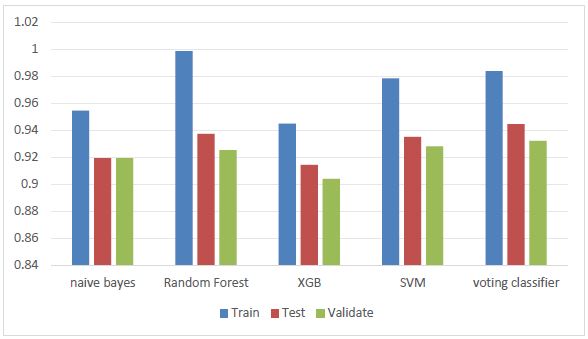Text Sentiment Detection and Classification Based on Integrated Learning Algorithm
DOI:
https://doi.org/10.5281/zenodo.11516191Keywords:
text emotion, integrated learning, machine learningAbstract
The aim of this paper is to explore the importance of textual sentiment detection in the field of Natural Language Processing and to classify and detect sentiment through various machine learning algorithms. Firstly, we train using Park Bayes, Random Forest, XGB and Support Vector Machine models, and then integrate them into a voting classifier for comparative analysis. The results show that the Random Forest model performs the best in the training set; and in both the validation set and the test set, the accuracy of the voting classifier is the highest, reaching 93.32% and 94.47%, respectively, which shows its superiority in the classification of text sentiment detection. Taken together, voting classifier has the best prediction results and provides an effective solution for text sentiment detection. This study not only provides an in-depth comparative analysis of the performance of different machine learning algorithms in text sentiment detection, but also provides a useful reference for subsequent related research and applications.
Downloads
References
J. Jin, F. Ni, S. Dai, K. Li, & B. Hong. (2024). Enhancing federated semi-supervised learning with out-of-distribution filtering amidst class mismatches. Journal of Computer Technology and Applied Mathematics, 1(1), 100-108.
S. Li, Y. Mo, & Z. Li. (2022). Automated pneumonia detection in chest x-ray images using deep learning model. Innovations in Applied Engineering and Technology, 1-6.
Z. Li, H. Yu, J. Xu, J. Liu, & Y. Mo. (2023). Stock market analysis and prediction using lstm: A case study on technology stocks. Innovations in Applied Engineering and Technology, 1-6.
K. Li, P. Xirui, J. Song, B. Hong, & J. Wang. (2024). The application of augmented reality (ar) in remote work and education. arXiv preprint arXiv:2404.10579.
K. Li, A. Zhu, P. Zhao, J. Song, & J. Liu. (2024). Utilizing deep learning to optimize software development processes. Journal of Computer Technology and Applied Mathematics, 1(1), 70-76.
T. Liu, S. Li, Y. Dong, Y. Mo, & S. He. (2024). Spam detection and classification based on distilbert deep learning algorithm. Applied Science and Engineering Journal for Advanced Research, 3(3), 6-10.
Y. Mo, H. Qin, Y. Dong, Z. Zhu, & Z. Li. (2024). Large language model (llm) ai text generation detection based on transformer deep learning algorithm. International Journal of Engineering and Management Research, 14(2), 154-159.
Y. Mo, S. Li, Y. Dong, Z. Zhu, & Z. Li. (2024). Password complexity prediction based on roberta algorithm. Applied Science and Engineering Journal for Advanced Research, 3(3), 1-5.
J. Zhang, A. Xiang, Y. Cheng, Q. Yang, & L. Wang. (2024). Research on detection of floating objects in river and lake based on ai intelligent image recognition. arXiv preprint arXiv:2404.06883.
J. Song, H. Liu, K. Li, J. Tian, & Y. Mo. (2024). A comprehensive evaluation and comparison of enhanced learning methods. Academic Journal of Science and Technology, 10(3), 167-171.
A. Zhu, K. Li, T. Wu, P. Zhao, & B. Hong. (2024). Cross-task multi-branch vision transformer for facial expression and mask wearing classification. Journal of Computer Technology and Applied Mathematics, 1(1), 46-53.
Li, Huan, Feng Xu, & Zheng Lin. (2023). ET-DM: Text to image via diffusion model with efficient Transformer. Displays, 80.
Lin, Zheng, & Feng Xu. (2023). Simulation of robot automatic control model based on artificial intelligence algorithm. 2nd International Conference on Artificial Intelligence and Autonomous Robot Systems (AIARS).
Qiu, Shushan, et al. (2022). Day-ahead optimal scheduling of power–gas–heating integrated energy system considering energy routing. Energy Reports, 8(2022), 1113-1122.
Chen, Jinfan, et al. (2023). Stochastic planning of integrated energy system based on correlation scenario generation method via Copula function considering multiple uncertainties in renewable energy sources and demands. IET Renewable Power Generation 17(12), 2978-2996.
Chen, Jinfan, et al. (2024). Reinforcement learning based two‐timescale energy management for energy hub. IET Renewable Power Generation 18(3), 476-488.
Zhan, Rongrong, et al. (2023). Operation strategy of energy router considering compressed air energy storage. 4th International Conference on Advanced Electrical and Energy Systems (AEES).
Chen, Jinfan, et al. (2023). Robust optimization based multi-level coordinated scheduling strategy for energy hub in spot market. 7th International Conference on Green Energy and Applications (ICGEA).
Li, Zhuoying, et al. (2024). AD-aligning: Emulating human-like generalization for cognitive domain adaptation in deep learning. arXiv preprint arXiv:2405.09582.
Meng, Yinan, et al. (2023). Spring-IMU fusion-based proprioception for feedback control of soft manipulators. IEEE/ASME Transactions on Mechatronics.

Downloads
Published
How to Cite
Issue
Section
ARK
License
Copyright (c) 2024 Zheng Lin, Zeyu Wang, Yue Zhu, Zichao Li, Hao Qin

This work is licensed under a Creative Commons Attribution 4.0 International License.
Research Articles in 'Applied Science and Engineering Journal for Advanced Research' are Open Access articles published under the Creative Commons CC BY License Creative Commons Attribution 4.0 International License http://creativecommons.org/licenses/by/4.0/. This license allows you to share – copy and redistribute the material in any medium or format. Adapt – remix, transform, and build upon the material for any purpose, even commercially.










